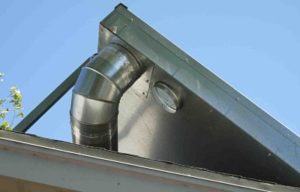Heating the House – Thermal Heating at the Urban Farm
The Urban Farm Thermal Heater
Imagine for a moment that you jump into your car that has been sitting in the sun in the middle of August or January for that matter – it’s kinda hot to oh my gosh. You burn your hands on the steering wheel and your tush on the seat. What if we could capture this heat and do something with it? That’s the idea behind the Urban Farm Thermal Heater.
This is something that I have dreamed about for years, but given that I am not an engineer implementing this was not something that was happening. Then my friend Bill Cunningham from Southwest Solar told me he had developed a Box heater, a metal box 10 feet long, 4 feet wide and 8 inches tall with a glass plate covering the top. Plus the inside is painted black. The panel is mounted on the roof pointing south at about a 40 degree angle to most effectively catch the winter suns heat. For those of you in the southern hemisphere the panel would need to face north.
The downside to this wonderful heater is that it only heats when the sun is out. Living in Phoenix however provides lots of sunny days so that is not much of a problem. Some of the upside includes that we are directly taking the suns heat for use in the Urban Farm and except for the low voltage blower fan that uses a small amount of energy there is no other electricity needed to run it.
Our thermal system is designed to heat the two bedrooms and bathroom on the north side of the house. There is a doorway with a drape across it that separates this area from the rest of my home. Amazingly the drape creates enough of a barrier to keep the area 5 to 10 degrees cooler in the summer.
So here is how it works. Air is pulled into the thermal unit through an 8 inch diameter hole in the back of the unit.
The unit is divided in half horizontally with a sheet of black painted sheet of metal. The air that enters the unit is drawn across the front of the panel from the left to the right side then passes to the underside of the pane to continue the heating process.
Mounted in the heating unit is a thermostat that comes on when the unit reaches 100 degrees. That way the heater does not start blowing heated air till it is warm enough. There is also a thermostat in the hall that allows me to control the heat blown into the house.

The blower unit is mounted inside the attic and connected through the roof to the heater unit. On the outside of the house the ducting is made of a flexible 8 inch insulated tubing and is encased inside sheet metal piping. The flexible insulated tubing runs through the attic and is delivered via a vent into my bedroom.
When I need the heat my intent is to leave the thermostat so that it will run anytime there is enough heat in the unit to heat my space. The vent is aimed at the block wall of my room so that the wall is used as a heat sink, storing warmth for later release.
The unit has just been installed and I don’t have any data yet on the efficacy of the unit. I will continue to add data as it comes available.
I recently emailed Bill and asked him for some technical data on the unit and here is what he said.
Short Answer: The thermostat in the solar heater comes on when the temp reaches 110F and goes off when it gets down to 90. The energy for the small blower uses less than 200 Watts.
Long answer: The solar heater can harvest up to about 10,000 BTU’s per hour, which is equivalent to 2,800Watts of heat into the house (more than 10 times the energy going into the blower). I think that the “real world” heat gain is at least 1500 Watts which is what a typical electric plug in portable heater consumes and delivers. Over a typical day the solar heater can probably deliver about 75,000 to 90,000 BTU’s to the house (depends mostly upon outside air temperature).
The solar heater is a great way to leverage the fossil energy into 10 times more, but since you have 2,000 watts of pv solar electric energy on your roof, (Blog post coming soon on this) so you are not using coal derived electricity like most other folks. End of lesson on solar and fossil energy theory. Typical nerd engineer answer: you ask me what time it is and I tell you how to build a clock!







